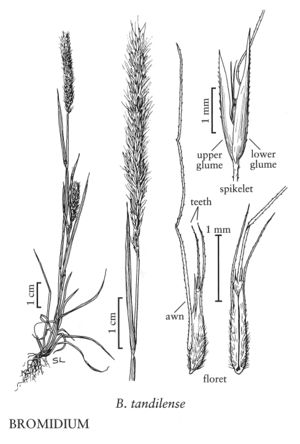Difference between revisions of "Bromidium tandilense"
FNA>Volume Importer |
imported>Volume Importer |
||
| Line 42: | Line 42: | ||
|publication year= | |publication year= | ||
|special status= | |special status= | ||
| − | |source xml=https:// | + | |source xml=https://bibilujan@bitbucket.org/aafc-mbb/fna-data-curation.git/src/bb6b7e3a7de7d3b7888a1ad48c7fd8f5c722d8d6/coarse_grained_fna_xml/V24/V24_986.xml |
|subfamily=Poaceae subfam. Pooideae | |subfamily=Poaceae subfam. Pooideae | ||
|tribe=Poaceae tribe Poeae | |tribe=Poaceae tribe Poeae | ||
Revision as of 21:52, 27 May 2020
Plants annual, tufted. Culms 5-50 cm, slender, erect. Sheaths smooth; ligules 1.5-3 mm, membranous, rounded to acute, entire; blades 2-10 cm long, 0.5-4 mm wide, flat. Panicles 0.9-8 cm long, (0.2) 0.7-1.5 cm wide, cylindrical, generally straw-colored or brown, appearing bristly; branches to 1 cm, ascending to appressed, with 1 branch at the lowest node; pedicels 0.1-0.7 mm, scabrous. Spikelets 2.6-3.6 mm. Glumes lanceolate, subequal, keels scabrous, sides smooth, apices acute; lower glumes 2.6-3.6 mm; upper glumes (2)2.4-3.5 mm; calluses pilose on all sides, hairs to 0.5 mm, dense; lemmas (1)1.4-1.6 mm, pilose, 5-veined, lateral veins prolonged into awnlike teeth, outer teeth (0.8)1-2 mm, inner teeth 0.1-0.2(0.5) mm, awns 4.5-6 mm, arising from the lower 1/3 of the lemmas, exceeding the glumes by 2-2.5 mm; paleas absent: anthers 0.2-0.5 mm, sometimes differing in length within a floret, often remaining on the apices of the caryopses. Caryopses 1-1.3 mm; hila oval; endosperm liquid or doughy. 2n = unknown.
Discussion
Bromidium tandilense is native to Argentina, Brazil, Uruguay, and Paraguay. It now grows around vernal pools in Solano, Monterey, and San Diego counties, California.
Selected References
None.
